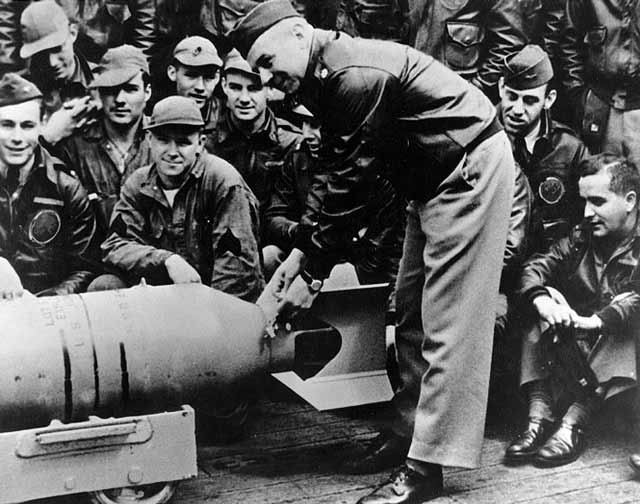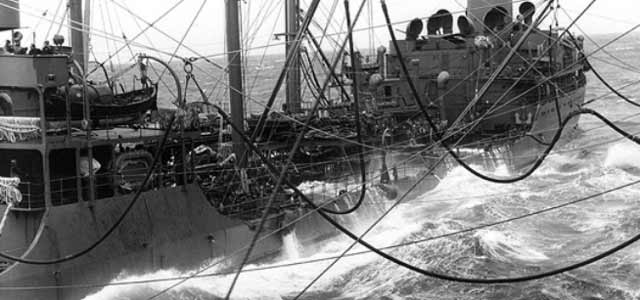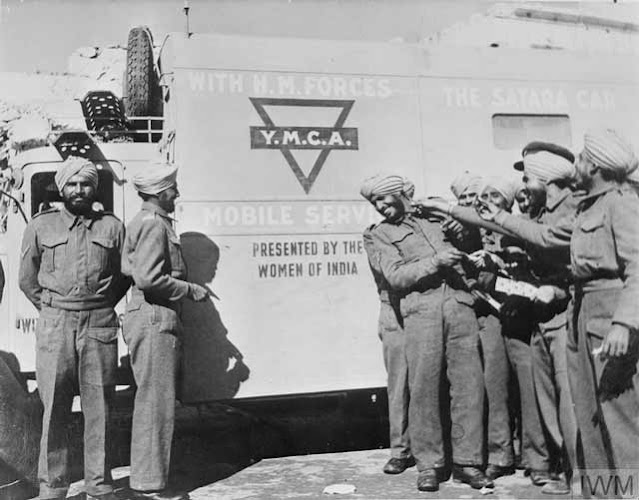Friday 17 April 1942
 |
| Douglas SBD "Dauntless" aboard the USS Enterprise (CV-6) April 17, 1942 (US Navy). |
Fortunately for the British, help is on the way in the form of part of the Chinese 38th Division. While he is under orders not to help the British, Chinese General Sun Li-jen disobeys and sends his 113th Regiment (1121 men) south toward the trapped British. British Lieutenant-General William Slim chips in the 7th Armored Brigade (Brigadier John Anstice) with two regiments of American M3 Stuart tanks and a battery of 25-pounder guns to help General Sun's infantry. This combined force battles its way south toward the trapped British infantry, making good progress in 114-degree Fahrenheit heat.
About 1000 miles (1500 km) east of Japan, Admiral "Bull" Halsey's Task Force 16 continues preparing for the Doolittle Raid on Tokyo. The deck crew of USS Hornet pulls the 16 B-25 bombers to the rear of the flight deck, loads them with four 500-lb bombs apiece and ammunition, and fuels them. The bombers also are fitted with broomsticks painted black in their tails to look like machine guns. All plane systems are checked even though the operation is not scheduled to begin for a couple of days.
The Luftwaffe continues building up its strength in the Black Sea region in order to support General Manstein's 11th Army, and this is producing results. KG 26 sinks 4125-ton transport Svanetiya as it is trying to bring reinforcements to Sevastopol, leading to the death of about 535 Soviet soldiers. Luftwaffe General Wolfram von Richthofen is bringing an entire air fleet - which usually supports an entire army group - into the area as units return from winter quarters in the Reich. While the ground contest is fairly even, there is no question that the Luftwaffe dominates the air over the Crimea.
After dark, RAF Bomber Command does a normal nighttime mission and sends 173 bombers (134 Wellingtons, 23 Stirlings, 11 Halifaxes, 5 Manchesters, and 7 Manchesters) over Hamburg. As is standard with these night raids, bombing accuracy is poor. The bombs start 75 fires, 33 large, in Hamburg, with 23 people killed and 66 injured. In minor operations, 22 Whitleys bomb St. Nazaire, four bomb Le Havre, six Blenheims attack targets in Holland, and nine bombers lay mines off Heligoland.
POWs: French General Henri Giraud, held in Königstein Castle near Dresden, escapes by making a 150-foot (46 m) rope out of torn bedsheets, twine, and copper wire. Giraud has alerted his family back in France of his plans in letters using a simple code, so they have placed a British Special Operations Executive (SOE) contact at Schandau. Giraud makes it to Schandau and, supplied there with identity papers and clothes, continues on to the Swiss border.
Resistance: The Gestapo reports that there has been an increase in resistance activities in the Rhineland. These include anti-German graffiti and "V for Victory" signs.
US/Vichy French Relations: In the evening, President Roosevelt announces that he is recalling the US Ambassador to France, Admiral William Leahy (Retired), due to Marshal Pétain's appointment of arch-collaborator Pierre Laval as Vice-Premier (and effective head of the French government). Leahy will remain in France through the end of the month.
Holocaust: It is "Bloody Friday" in the Jewish District of Warsaw. In the evening, German officers and non-commissioned officers from the police, SS, Gestapo, and Jewish employees of the Jewish Ghetto Police undertake a "hunt" under the direction of SS leader Karl Brandt. The President of the Warsaw Judenrat, Adam Czerniaków, writes in his diary:
April 2, 1942: Doolittle Raiders Leave Port
April 3, 1942: Japanese Attack in Bataan
April 4, 1942: Luftwaffe Attacks Kronstadt
April 5, 1942: Japanese Easter Sunday Raid on Ceylon
April 6, 1942: Japanese Devastation In Bay of Bengal
April 7, 1942: Valletta, Malta, Destroyed
April 8, 1942: US Bataan Defenses Collapse
April 9, 1942: US Defeat in Bataan
April 10, 1942: The Bataan Death March
April 11, 1942: The Sea War Heats Up
April 12, 1942: Essen Raids Conclude Dismally
April 13, 1942: Convoy QP-10 Destruction
April 14, 1942: Demyansk Breakout Attempt
April 15, 1942: Sobibor Extermination Camp Opens
April 16, 1942: Oil Field Ablaze in Burma
April 17, 1942: The Disastrous Augsburg Raid
April 18, 1942: The Doolittle Raid bombs Japan
April 19, 1942: British in Burma Escape
April 20, 1942: The Operation Calendar Disaster
April 21, 1942: Germans Relieve Demyansk
Battle of the Pacific: The Bataan Death March continues in the Philippines. Prisoners who have survived the roughly 65-mile (105 km) walk to Camp O'Donnell under brutal conditions find little relief there. Men collapse at the camp and many die of exposure. The roads to the south remain clogged with shuffling columns of underfed and dehydrated men hoping they won't fall behind the slow pace and be bayoneted by pitiless Japanese guards. The sides of the roads are littered with dead bodies. Of the 80,000 Allied POWs who began the march, only about 54,000 even make it to the camp.
About 1000 miles (1500 km) east of Japan, Admiral "Bull" Halsey's Task Force 16 continues preparing for the Doolittle Raid on Tokyo. The deck crew of USS Hornet pulls the 16 B-25 bombers to the rear of the flight deck, loads them with four 500-lb bombs apiece and ammunition, and fuels them. The bombers also are fitted with broomsticks painted black in their tails to look like machine guns. All plane systems are checked even though the operation is not scheduled to begin for a couple of days.
Lieutenant Colonel James Doolittle and the Hornet's Captain Marc Mitscher hold a small ceremony on the Hornet's flight deck with the aircrew. They tie "friendship medals" given to the United States by Japan before the war - this apparently was President Roosevelt's idea, who wanted to return the medals in proper fashion. The fleet oilers refuel the ships and then withdraw with the destroyers to the east. The two aircraft carriers, Hornet and Enterprise, continue heading west at 20 knots (37 km/h; 23 mph) in radio silence.
 |
| Lieutenant Colonel James Doolittle pins a Japanese "Peace and Friendship" medal to a bomb destined to be dropped on Tokyo, 17 April 1942 (US Navy). |
Eastern Front: General Franz Halder notes in his war diary that there are "confused movements and radio silence" opposite General Kleist's front along the Mius River from south of Kharkiv to Taganrog on the Sea of Azov. While Halder does not flesh this out, it is well known among German commanders that Soviet radio silence usually presages an attack.
Following Hitler's lead, Halder is becoming busy preparing for Operation Blau, the upcoming offensive in Kleist's area toward the Caucasus. Troops are being transferred from Army Group Center to the south (held in reserve for now) and they need support. Today, Halder meets with Reichsleiter Konstantin Hierl, head of the Reich Labour Service (Reichsarbeitsdienst; RAD), to arrange support services for Operation Blau. At some point, Halder notes in his diary, these Labour Service personnel face "incorporation into Army." Halder also meets with the Italian transportation chief, General de Raimondo, and discusses strategy for Blau with General von Sodenstern, the chief of staff for Army Group South.
The Luftwaffe continues building up its strength in the Black Sea region in order to support General Manstein's 11th Army, and this is producing results. KG 26 sinks 4125-ton transport Svanetiya as it is trying to bring reinforcements to Sevastopol, leading to the death of about 535 Soviet soldiers. Luftwaffe General Wolfram von Richthofen is bringing an entire air fleet - which usually supports an entire army group - into the area as units return from winter quarters in the Reich. While the ground contest is fairly even, there is no question that the Luftwaffe dominates the air over the Crimea.
 |
| Douglas F-3 "Havoc" aerial reconnaissance aircraft, April 17, 1942. |
European Air Operations: During the day, Arthur "Bomber" Harris decides to try something new to address the poor accuracy of his bomber force. He sends a dozen Lancaster bombers to Augsburg while 30 Boston bombers stage a diversionary raid to northern France. The controversial Augsburg raid succeeds in one respect - the eight bombers that get through do make accurate bombing runs. However, the Luftwaffe has something to say about all this, and its pilots shoot down four of the Lancasters en route to the target and three others over Augsburg itself. An additional Boston is lost during the diversionary raid. Many of the bombers that do make it back are damaged. Squadron Leader J.D. Nettleton of RAF No. 44 Squadron, flying one of the five damaged planes that make it back from Augsburg, receives the Victoria Cross for his heroism during this raid.
After dark, RAF Bomber Command does a normal nighttime mission and sends 173 bombers (134 Wellingtons, 23 Stirlings, 11 Halifaxes, 5 Manchesters, and 7 Manchesters) over Hamburg. As is standard with these night raids, bombing accuracy is poor. The bombs start 75 fires, 33 large, in Hamburg, with 23 people killed and 66 injured. In minor operations, 22 Whitleys bomb St. Nazaire, four bomb Le Havre, six Blenheims attack targets in Holland, and nine bombers lay mines off Heligoland.
Overall, it is a bad day for the RAF. Out of 214 sorties, it loses 10 aircraft. This loss ratio of 4.7% is too high for sustainable operations. Thus, Harris decides to end his experimental daylight raids to focus exclusively on night attacks.
 |
| "The crew of HMS UPRIGHT with their Jolly Roger Flag recording their successes." Holy Loch, 17 April 1942. © IWM A 8426. |
Battle of the Atlantic: U-123 (Kptlt. Reinhard Hardegen), on its eighth patrol out of Lorient, completes one of the war's best patrols by sinking 4834-ton US freighter Alcoa Guide about 300 miles east of Cape Hatteras. Out of torpedoes, Hardegen maneuvers close to the freighter and uses the last of his deck-gun ammunition to shell the ship from only 400 yards. The Alcoa Guide's master, Leroy Cobb, tries to ram the U-boat but fails, so the crew abandons the ship, which sinks at 05:23. There are six dead and 28 survivors. One survivor is at sea until 18 May when he is picked up by freighter Hororata.
During this patrol, U-123 has sunk 8 ships of 39,917 tons and damaged three more of 24,310 tons for a total of 64,227 tons. It is because of successes like this along the east coast of the United States that Admiral Doenitz extends his Operation Paukenschlag through the summer.
 |
| A fleet tanker refueling the ships of the Doolittle Raid, 17 April 1942 (US Navy). |
U-66 (KrvKpt. Richard Zapp), on its fifth patrol out of Lorient, torpedoes and sinks 11,020-ton Panamanian tanker Heinrich von Riedemann between Grenada and Isla La Blanquilla. All 44 men on board survive in lifeboats, with 15 men landing at Blanquilla and 29 picked up by passing freighter Karmt the same day as the sinking.
Activity remains bustling along the Arctic convoy route even though no action takes place today. Soviet submarines K-21, S-1010, and ShCh-401 begin a patrol along the Arctic coast and two Soviet destroyers join Convoy PQ-14 to help it into port. U-376, meanwhile, is shadowing the convoy and fires torpedoes at Royal Navy cruiser HMS Edinburgh east of Bear Island, but misses. German U-boat commanders routinely complain about defective torpedoes during this stage of the war, with the problem ultimately traced to the magnetic detonators being triggered prematurely due to variations in the earth's magnetic field.
 |
| "One of a fleet of YMCA mobile canteens presented by the Women of India distributing free chocolate to troops in Benghazi." © IWM K 1930. |
Battle of the Mediterranean: Luftwaffe General Albert Kesselring's air offensive against Malta, begun on 20 March 1942, is over for the time being. With the skies temporarily clear, the British issue orders today for troops from Army infantry brigades to help clear and restore airfields for operations.
POWs: French General Henri Giraud, held in Königstein Castle near Dresden, escapes by making a 150-foot (46 m) rope out of torn bedsheets, twine, and copper wire. Giraud has alerted his family back in France of his plans in letters using a simple code, so they have placed a British Special Operations Executive (SOE) contact at Schandau. Giraud makes it to Schandau and, supplied there with identity papers and clothes, continues on to the Swiss border.
Resistance: The Gestapo reports that there has been an increase in resistance activities in the Rhineland. These include anti-German graffiti and "V for Victory" signs.
US/Vichy French Relations: In the evening, President Roosevelt announces that he is recalling the US Ambassador to France, Admiral William Leahy (Retired), due to Marshal Pétain's appointment of arch-collaborator Pierre Laval as Vice-Premier (and effective head of the French government). Leahy will remain in France through the end of the month.
Holocaust: It is "Bloody Friday" in the Jewish District of Warsaw. In the evening, German officers and non-commissioned officers from the police, SS, Gestapo, and Jewish employees of the Jewish Ghetto Police undertake a "hunt" under the direction of SS leader Karl Brandt. The President of the Warsaw Judenrat, Adam Czerniaków, writes in his diary:
There is panic in the district. The shops are being closed. The population is gathering in the street in front of the houses. I went out onto the street and walked through several streets to calm the people down.
Cars containing armed Germans each assisted by a Jew of the Jewish Ghetto Police round up individuals and families based on a list of obscure derivation. The victims are given a few minutes to round up a very few possessions (to allay their suspicions) and then driven to a central spot and executed. A total of 52 people (both women and men) are shot. By the standards of the Holocaust, this is not a lot, but the entire city's Jewish population is terrorized. "Bloody Friday" is considered a prelude to the worst extermination campaigns that begin soon after.
American Homefront: In an article by H. Dyson Carter in The Family Circle magazine, the question is raised of whether comics are bad for children. Carter's answer is a resounding 'No." She (presumably, given the first name is shown as an initial and this is a woman's magazine) writes about the popularity of comics with children:
Yes, you say, but is this healthy? And what you mean is: Isn’t it dangerous to put so much faith in fantasy? Isn’t this escapism? Doctors Baker and Lourie answer no to both questions. Your child isn’t wrong. It’s you who are wrong. You’ve lost touch, as adults invariably do, with the essence of childhood-which is a magic compound of imagination and fantasy. It isn’t so much his faith that a child puts into these comic book stories. It’s his gathering emotions, his craving for self-expression, his desire to be a part of great adventures. And great adventures, at his age, are limited only by the limits of his imagination. And where his imagination leaves off, Superman begins.
This article is the first shot in a long war about this particular issue. In the 1950s, Senator Estes Kefauver and Fredric Wertham will lead a crusade against comic books, so there is hardly unanimity on this topic. It is worth pointing out that the "Batman" and "Superman" comic series are both relatively new in 1942, with a classic serial of "The Batman" running in theaters. In the long run, the view expressed in this 1942 article ultimately prevails.
 |
| The Family Circle magazine, 17 April 1942, asks the eternal question: Are comics bad for kids. |
April 1942
April 1, 1942: Convoys Come to the USAApril 2, 1942: Doolittle Raiders Leave Port
April 3, 1942: Japanese Attack in Bataan
April 4, 1942: Luftwaffe Attacks Kronstadt
April 5, 1942: Japanese Easter Sunday Raid on Ceylon
April 6, 1942: Japanese Devastation In Bay of Bengal
April 7, 1942: Valletta, Malta, Destroyed
April 8, 1942: US Bataan Defenses Collapse
April 9, 1942: US Defeat in Bataan
April 10, 1942: The Bataan Death March
April 11, 1942: The Sea War Heats Up
April 12, 1942: Essen Raids Conclude Dismally
April 13, 1942: Convoy QP-10 Destruction
April 14, 1942: Demyansk Breakout Attempt
April 15, 1942: Sobibor Extermination Camp Opens
April 16, 1942: Oil Field Ablaze in Burma
April 17, 1942: The Disastrous Augsburg Raid
April 18, 1942: The Doolittle Raid bombs Japan
April 19, 1942: British in Burma Escape
April 20, 1942: The Operation Calendar Disaster
April 21, 1942: Germans Relieve Demyansk


No comments:
Post a Comment